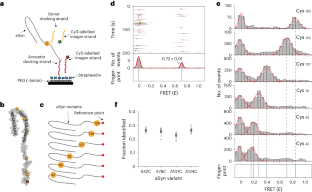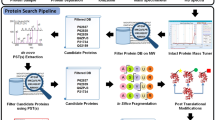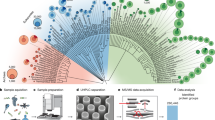Abstract
Proteins are the primary functional actors of the cell. While proteoform diversity is known to be highly biologically relevant, current protein analysis methods are of limited use for distinguishing proteoforms. Mass spectrometric methods, in particular, often provide only ambiguous information on post-translational modification sites, and sequences of co-existing modifications may not be resolved. Here we demonstrate fluorescence resonance energy transfer (FRET)-based single-molecule protein fingerprinting to map the location of individual amino acids and post-translational modifications within single full-length protein molecules. Our data show that both intrinsically disordered proteins and folded globular proteins can be fingerprinted with a subnanometer resolution, achieved by probing the amino acids one by one using single-molecule FRET via DNA exchange. This capability was demonstrated through the analysis of alpha-synuclein, an intrinsically disordered protein, by accurately quantifying isoforms in mixtures using a machine learning classifier, and by determining the locations of two O-GlcNAc moieties. Furthermore, we demonstrate fingerprinting of the globular proteins Bcl-2-like protein 1, procalcitonin and S100A9. We anticipate that our ability to perform proteoform identification with the ultimate sensitivity may unlock exciting new venues in proteomics research and biomarker-based diagnosis.
This is a preview of subscription content, access via your institution
Access options
Access Nature and 54 other Nature Portfolio journals
Get Nature+, our best-value online-access subscription
$29.99 / 30 days
cancel any time
Subscribe to this journal
Receive 12 print issues and online access
$259.00 per year
only $21.58 per issue
Buy this article
- Purchase on Springer Link
- Instant access to full article PDF
Prices may be subject to local taxes which are calculated during checkout




Similar content being viewed by others
Data availability
The data supporting the main finding of this study are available at the publicly accessible online repository Zenodo with identifier https://doi.org/10.5281/zenodo.10179066. Any additional data are available from the corresponding author upon request.
Code availability
The algorithms for the codes supporting the main findings of this study are available at https://doi.org/10.5281/zenodo.10156504. Any additional information concerning the code is available from the corresponding author upon request.
References
Aebersold, R. et al. How many human proteoforms are there? Nat. Chem. Biol. 14, 206–214 (2018).
Kim, H. K., Pham, M. H. C., Ko, K. S., Rhee, B. D. & Han, J. Alternative splicing isoforms in health and disease. Pflügers Arch. 470, 995–1016 (2018).
Paronetto, M. P., Passacantilli, I. & Sette, C. Alternative splicing and cell survival: from tissue homeostasis to disease. Cell Death Differ. 23, 1919–1929 (2016).
Lin, H. & Caroll, K. S. Introduction: posttranslational protein modification. Chem. Rev. 118, 887–888 (2018).
Carbonara, K., Andonovski, M. & Coorssen, J. R. Proteomes are of proteoforms: embracing the complexity. Proteomes 9, 38 (2021).
Benson, M. D., Ngo, D., Ganz, P. & Gerszten, R. E. Emerging affinity reagents for high throughput proteomics: trust, but verify. Circulation 140, 1610–1612 (2019).
Yang, Y. et al. Hybrid mass spectrometry approaches in glycoprotein analysis and their usage in scoring biosimilarity. Nat. Commun. 7, 13397 (2016).
Čaval, T., Tian, W., Yang, Z., Clausen, H. & Heck, A. J. R. Direct quality control of glycoengineered erythropoietin variants. Nat. Commun. 9, 3342 (2018).
Siuti, N. & Kelleher, N. L. Decoding protein modifications using top-down mass spectrometry. Nat. Methods 410, 817–821 (2007).
Wang, Y., Zhao, Y., Bollas, A., Wang, Y. & Au, K. F. Nanopore sequencing technology, bioinformatics and applications. Nat. Biotechnol. 39, 1348–1365 (2021).
Ardui, S., Ameur, A., Vermeesch, J. R. & Hestand, M. S. Single molecule real-time (SMRT) sequencing comes of age: applications and utilities for medical diagnostics. Nucleic Acids Res. 46, 2159–2168 (2018).
Restrepo-Pérez, L., Joo, C. & Dekker, C. Paving the way to single-molecule protein sequencing. Nat. Nanotechnol. 13, 786–796 (2018).
Alfaro, J. A. et al. The emerging landscape of single-molecule protein sequencing technologies. Nat. Methods 18, 604–617 (2021).
Floyd, B. M. & Marcotte, E. M. Protein sequencing, one molecule at a time. Annu. Rev. Biophys. 51, 181–200 (2022).
Timp, W. & Timp, G. Beyond mass spectrometry, the next step in proteomics. Sci. Adv. 6, eaax8978 (2020).
Swaminathan, J., Boulgakov, A. A. & Marcotte, E. M. A theoretical justification for single molecule peptide sequencing. PLoS Comput. Biol. 11, e1004080 (2015).
Rodriques, S. G., Marblestone, A. H. & Boyden, E. S. A theoretical analysis of single molecule protein sequencing via weak binding spectra. PLoS ONE 14, e0212868 (2019).
Yao, Y., Docter, M., Van Ginkel, J., De Ridder, D. & Joo, C. Single-molecule protein sequencing through fingerprinting: computational assessment. Phys. Biol. 12, 10–16 (2015).
de Lannoy, C. V. et al. Evaluation of FRET X for single-molecule protein fingerprinting. iScience 24, 103239 (2021).
Yu, L. et al. Unidirectional single-file transport of full-length proteins through a nanopore. Nat. Biotechnol. 41, 1130–1139 (2023).
van Ginkel, J. et al. Single-molecule peptide fingerprinting. Proc. Natl Acad. Sci. USA 115, 3338–3343 (2018).
Swaminathan, J. et al. Highly parallel single-molecule identification of proteins in zeptomole-scale mixtures. Nat. Biotechnol. 36, 1076–1082 (2018).
Shrestha, P. et al. Single-molecule mechanical fingerprinting with DNA nanoswitch calipers. Nat. Nanotechnol. 16, 1362–1370 (2021).
Filius, M., Kim, S. H., Severins, I. & Joo, C. High-resolution single-molecule FRET via DNA exchange (FRET X). Nano Lett. 21, 3295–3301 (2021).
Filius, M., van Wee, R. & Joo, C. in Single Molecule Analysis: Methods and Protocols (eds Heller, I. et al.) 203–213 (Springer, 2024).
Van Wee, R., Filius, M. & Joo, C. Completing the canvas: advances and challenges for DNA-PAINT super-resolution imaging. Trends Biochem. Sci. 11, 918–930 (2021).
Schnitzbauer, J., Strauss, M. T., Schlichthaerle, T., Schueder, F. & Jungmann, R. Super-resolution microscopy with DNA-PAINT. Nat. Protoc. 12, 1198–1228 (2017).
Shi, X. et al. Quantitative fluorescence labeling of aldehyde-tagged proteins for single-molecule imaging. Nat. Methods 9, 499–503 (2012).
Schuler, B. & Hofmann, H. Single-molecule spectroscopy of protein folding dynamics—expanding scope and timescales. Curr. Opin. Struct. Biol. 23, 36–47 (2013).
Yang, X. & Qian, K. Protein O-GlcNAcylation: emerging mechanisms and functions. Nat. Rev. Mol. Cell Biol. 18, 452–465 (2017).
Vellosillo, P. & Minguez, P. A global map of associations between types of protein posttranslational modifications and human genetic diseases. iScience 24, 102917 (2021).
Mauri, T. et al. O-GlcNAcylation prediction: an unattained objective. Adv. Appl. Bioinform. Chem. 14, 87–102 (2021).
Shi, J., Ruijtenbeek, R. & Pieters, R. J. Demystifying O-GlcNAcylation: hints from peptide substrates. Glycobiology 28, 814–824 (2018).
Shen, D. L. et al. Catalytic promiscuity of O-GlcNAc transferase enables unexpected metabolic engineering of cytoplasmic proteins with 2-azido-2-deoxy-glucose. ACS Chem. Biol. 12, 206–213 (2017).
Mayer, A., Gloster, T. M., Chou, W. K., Vocadlo, D. J. & Tanner, M. E. 6′-Azido-6′-deoxy-UDP-N-acetylglucosamine as a glycosyltransferase substrate. Bioorg. Med. Chem. Lett. 21, 1199–1201 (2011).
Macdonald, J. I., Munch, H. K., Moore, T. & Francis, M. B. One-step site-specific modification of native proteins with 2-pyridinecarboxyaldehydes. Nat. Chem. Biol. 11, 326–331 (2015).
Wang, S. et al. S100A8/A9 in inflammation. Front. Immunol. 9, 1298 (2018).
Vijayan, A. L. et al. Procalcitonin: a promising diagnostic marker for sepsis and antibiotic therapy. J. Intensive Care 5, 51 (2017).
Senior, A. W. et al. Improved protein structure prediction using potentials from deep learning. Nature 577, 706–710 (2020).
Jumper, J. et al. Highly accurate protein structure prediction with AlphaFold. Nature 596, 583–589 (2021).
Jungmann, R. et al. Multiplexed 3D cellular super-resolution imaging with DNA-PAINT and Exchange-PAINT. Nat. Methods 11, 313–318 (2014).
Erickson, H. P. Size and shape of protein molecules at the nanometer level determined by sedimentation, gel filtration, and electron microscopy. Biol. Proced. Online 11, 32–51 (2009).
Ree, R., Varland, S. & Arnesen, T. Spotlight on protein N-terminal acetylation. Exp. Mol. Med. 50, 1–13 (2018).
Bloom, S. et al. Decarboxylative alkylation for site-selective bioconjugation of native proteins via oxidation potentials. Nat. Chem. 10, 205–211 (2018).
Ramirez, D. H. et al. Engineering a proximity-directed O-GlcNAc transferase for selective protein O-GlcNAcylation in cells. ACS Chem. Biol. 15, 1059–1066 (2020).
Yang, Y.-Y., Ascano, J. M. & Hang, H. C. Bioorthogonal chemical reporters for monitoring protein acetylation. J. Am. Chem. Soc. 132, 3640–3641 (2010).
Westcott, N. P., Fernandez, J. P., Molina, H. & Hang, H. C. Chemical proteomics reveals ADP-ribosylation of small GTPases during oxidative stress. Nat. Chem. Biol. 13, 302–308 (2017).
Rabuka, D., Hubbard, S. C., Laughlin, S. T., Argade, S. P. & Bertozzi, C. R. A chemical reporter strategy to probe glycoprotein fucosylation. J. Am. Chem. Soc. 128, 12078–12079 (2006).
Boeggeman, E. et al. Direct identification of nonreducing GlcNAc residues on N-glycans of glycoproteins using a novel chemoenzymatic method. Bioconjugate Chem. 18, 806–814 (2007).
van Geel, R. et al. Chemoenzymatic conjugation of toxic payloads to the globally conserved N-glycan of native mAbs provides homogeneous and highly efficacious antibody–drug conjugates. Bioconjugate Chem. 26, 2233–2242 (2015).
Tate, E. W., Kalesh, K. A., Lanyon-Hogg, T., Storck, E. M. & Thinon, E. Global profiling of protein lipidation using chemical proteomic technologies. Curr. Opin. Chem. Biol. 24, 48–57 (2015).
Anderson, N. L. & Anderson, N. G. The human plasma proteome: history, character, and diagnostic prospects. Mol. Cell. Proteom. 1, 845–867 (2002).
Han, X., Aslanian, A. & Yates, J. R. Mass spectrometry for proteomics. Curr. Opin. Chem. Biol. 12, 483–490 (2008).
Filius, M. et al. High-speed super-resolution imaging using protein-assisted DNA-PAINT. Nano Lett. 20, 2264–2270 (2020).
Kim, S. H., Kim, H., Jeong, H. & Yoon, T. Y. Encoding multiple virtual signals in DNA barcodes with single-molecule FRET. Nano Lett. 21, 1694–1701 (2021).
McCann, J. J., Choi, U. B., Zheng, L., Weninger, K. & Bowen, M. E. Optimizing methods to recover absolute FRET efficiency from immobilized single molecules. Biophys. J. 99, 961–970 (2010).
Cristianini, N. & Shawe-Taylor, J. An Introduction to Support Vector Machines and Other Kernel-based Learning Methods (Cambridge University Press, 2000).
Pedregosa, F. et al. Scikit-learn: machine learning in Python. J. Mach. Learn. Res. 12, 2825–2830 (2011).
Pabst, M. et al. A general approach to explore prokaryotic protein glycosylation reveals the unique surface layer modulation of an anammox bacterium. ISME J. 16, 346–357 (2022).
Chuh, K. N., Zaro, B. W., Piller, F., Piller, V. & Pratt, M. R. Changes in metabolic chemical reporter structure yield a selective probe of O-GlcNAc modification. J. Am. Chem. Soc. 136, 12283–12295 (2014).
Acknowledgements
C.J. and D.d.R. acknowledge funding from NWO-I (SMPS). C.J. acknowledges funding from NWO (Vici, VI.C.202.015), the Basic Science Research Program (NRF-2023R1A2C2004745) and Frontier 10-10 (Ewha Womans University). Y.W. was funded by a Chinese Scholarship Council (CSC) grant.
Author information
Authors and Affiliations
Contributions
M.F. and C.J. initiated and designed the project. M.F. designed and performed the protein labelling procedures. M.F. and R.v.W. performed the single-molecule FRET X experiments. I.W. and C.d.A.P. expressed and purified the proteins. C.d.L. wrote the software for and performed the fingerprinting predictions and protein classification. D.d.R. supervised the fingerprinting prediction simulations. S.H.K. wrote the automated peak-finding code for single-molecule FRET X analysis. M.F. and Z.L. conceptualized the O-GlcNAc site mapping, and designed the chemoenzymatic and N-terminal labelling strategies. Y.W. and G.-J.B. synthesized UDP-azido-O-GlcNAc for protein O-GlcNAcylation. M.P. performed proteomic analysis. M.F., S.H.K., C.d.L. and C.J. analysed and discussed the data. M.F., R.v.W. and C.J. prepared the initial draft of the manuscript. All authors read and approved the manuscript.
Corresponding author
Ethics declarations
Competing interests
C.J., M.F., C.d.L. and D.d.R. hold a patent on single-molecule FRET for protein characterization (patent number WO2021049940). C.J., M.F. and Z.L. have filed a patent for the bifunctional linker for N-terminal protein modification. The other authors declare no competing interests.
Peer review
Peer review information
Nature Nanotechnology thanks Carlos Penedo and the other, anonymous, reviewer(s) for their contribution to the peer review of this work.
Additional information
Publisher’s note Springer Nature remains neutral with regard to jurisdictional claims in published maps and institutional affiliations.
Supplementary information
Supplementary Information
Supplementary Figs. 1–8 and Tables 1 and 2.
Rights and permissions
Springer Nature or its licensor (e.g. a society or other partner) holds exclusive rights to this article under a publishing agreement with the author(s) or other rightsholder(s); author self-archiving of the accepted manuscript version of this article is solely governed by the terms of such publishing agreement and applicable law.
About this article
Cite this article
Filius, M., van Wee, R., de Lannoy, C. et al. Full-length single-molecule protein fingerprinting. Nat. Nanotechnol. (2024). https://doi.org/10.1038/s41565-023-01598-7
Received:
Accepted:
Published:
DOI: https://doi.org/10.1038/s41565-023-01598-7
This article is cited by
-
Topographic fingerprinting of single proteins and proteoforms
Nature Nanotechnology (2024)



